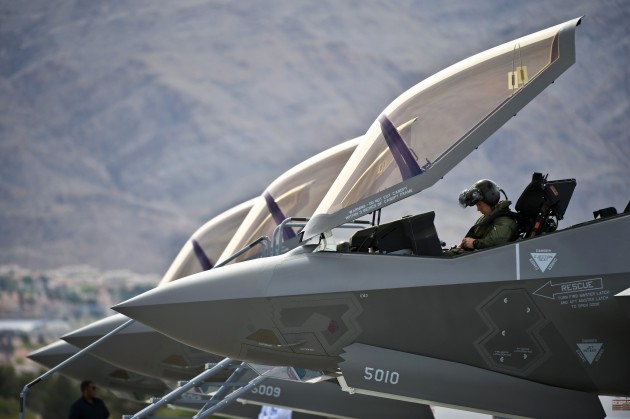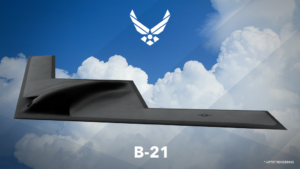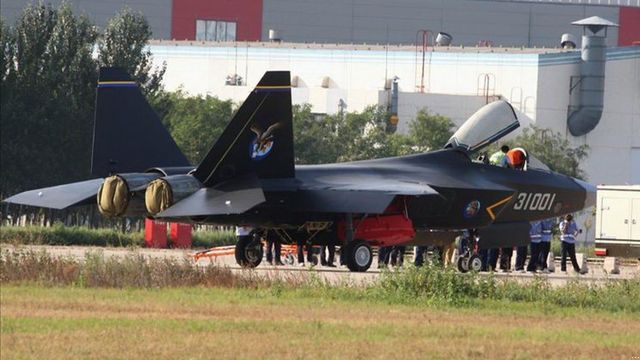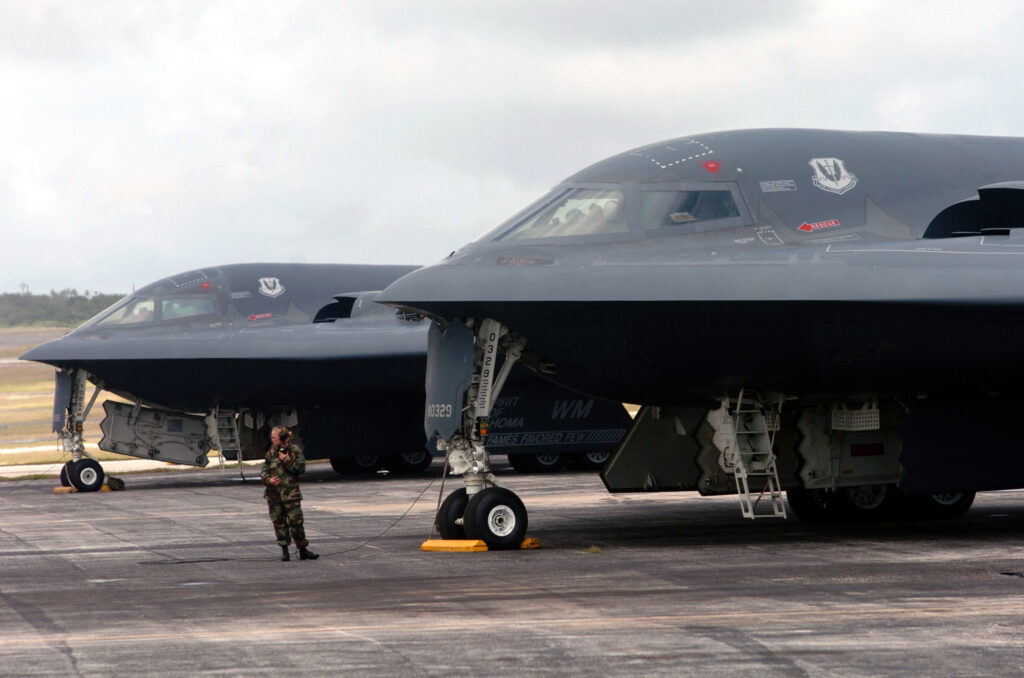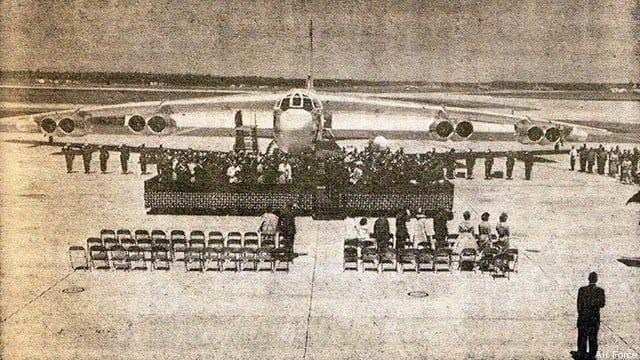Up the Buy ASAP: Fixing American Airpower
Posted on
The US Air Force is stretched to the brink, with an air fleet too small and too old to meet burgeoning high-tech threats from Russia and China. We need to buy more aircraft, newer aircraft, and faster. For a start, President Trump should ask Congress to double F-35A Joint Strike Fighter production from a paltry 48 a year in fiscal 2018 to 100 a year by 2020. This would solve two crucial challenges: achieving economic production quantities and getting modern combat aircraft in time to meet rising threats.
The US and its allies are starting to rise to the challenge. As the Royal Air Force celebrated its 100th anniversary last weekend at the Royal International Air Tattoo, it pledged to lead the way in new air combat concepts of operation. A Franco-German plan to build a sixth-generation fighter dominated discussion at this week’s Farnborough air show. Meanwhile, President Trump has called on NATO nations to double their spending goals. Perhaps it’s time for the US president to put his own airpower “house” in order by recapitalizing his geriatric Air Force faster so it won’t take nearly half a century to modernize its aging equipment.
The F-35 fighter, B-21 bomber, KC-46 tanker, and many other key airpower modernization efforts must be high priorities to ensure our national security strategy requirements can be met. For too long, key Air Force programs have been delayed by anemic funding, a focus on prolonged counterinsurgencies, and a lack of commitment to much-needed modernization.. As a result, the US runs the risk of catastrophic consequences in the major regional conflicts that lay ahead:
- China is aggressively asserting itself in the Pacific and beyond;
- Russia continues its overt use of force in places like Ukraine and Syria;
- North Korea and Iran still pose significant threats;
- new regions like the Arctic add to the security picture; and
- regional instability still dominates in places like the Middle East and Africa.
In each one of these scenarios, airpower provides indispensable options to national leaders.
But as Air Force Secretary Heather Wilson has remarked, “we have an Air Force that is the oldest Air Force and the smallest Air Force in its history.” Senate Armed Services Committee chairman John McCain declared, “this is a full-blown crisis, and if left unresolved, it will call into question the Air Force’s ability to accomplish its mission.” And that’s just two of the most prominent voices in this chorus. With adversaries aggressively pushing, Congress and the Defense Department must act fast to realign Air Force capabilities and capacity with operational requirements, not hobbling them to meet arbitrary budget targets.
Quality & Quantity
Competing states are hardly standing still when it comes to technology. Russia’s Su-57, along with China’s J-20 and J-31, are stealthy designs. Even if the nightmare scenario of direct conflict between great powers never comes to pass, these advanced aircraft will invariably be exported to other nations once they are fully operational.
Even allies like France and Germany are pressing ahead with advanced designs that involve stealth, advanced sensors, and significant computing power. Advantages once held solely by the United States have evaporated as time has passed. Many of the key attributes on which today’s US Air Force is built date back to the Eisenhower Administration. It should come as no surprise that others have used that time to copy our “advanced” technologies and, in many instances, take them to the next level.
But technology is not the only issue here. It is important to assess whether the Air Force will have enough aircraft to meet demand. The answer is troubling. Since the end of the Cold War, the United States has consistently failed to buy enough Air Force planes to meet the demands of its national security strategies.
The proof is the string of acquisition programs prematurely cancelled to save near-term dollars and defer modernization to the indefinite “future.” This began with the B-2, when a requirement for 100 bombers was stopped down to an ultimate purchase of just 21. (One later crashed). Next, the F-22 requirement for over 700 aircraft devolved to the actual purchase of just 187.
Now, the F-35 is facing challenges when it comes to matching the requirement with the ultimate buy. While production is underway, the rate necessary to efficiently and effectively recapitalize the force has yet to be attained. Current plans are to buy less than half of the stated design production rate. Additionally, word from the Pentagon suggests senior leaders may be considering truncating the F-35 buy below the still-official requirement of 1,763.
This short-sighted pattern creates a host of problem. First, truncating programs imposes a heavy cost upon the nation for relatively marginal return. Airplanes as complex as the B-2, F-22 and F-35 require tremendous investment in research and development.
Expending billions of dollars creating the necessary technology, but failing to buy as many planes as needed, is like building a house but never furnishing it because beds, chairs, and tables seem too expensive. The decision is irrational: The bulk of the cost was incurred in constructing the house. As long as the requirement for shelter still exists, the wisest option is to amortize the construction investment. The same holds true for combat airplanes. As long as the mission requirement exists, the most efficient and effective method to meet the need is to take advantage of sunk development cost and produce the airframes in a rapid fashion.
Vicious Circles
The problems keep compounding long after the initial decision to truncate production. Just because you stop buying something, the mission you needed it for doesn’t just go away. So cancelling a production run prematurely almost always leads to a new development effort a few years later to fill the original requirement.
Repeating this cycle over and over is self-defeating and unaffordable, imposing tremendous cost on the American taxpayer for relatively little return. It’s like digging the foundation for a house, stopping because it costs too much, and then digging a new, slightly different foundation on a different lot a few years later, then scrapping that construction project too. You keep doing the hard part without reaping the benefits.
In the meantime, with too few new airplanes acquired, the services must extend the lives of remaining aircraft to keep performing the mission. This stopgap creates a whole new layer of cost because parts wear out and electronics become obsolete, requiring expensive refits. But since the dated design philosophies and vintage technology of these legacy planes limit their combat potential, upgrades often expend a lot of money for marginal return.
This limitation is especially acute with non-stealth aircraft. In modern combat, there is no such thing as a silver bullet, and “stealthy” does not mean “invisible,” but a technology such as stealth radically complicates an enemy’s defensive calculus. Planes like the B-2 and F-22 were designed to be hard for radar to detect and track. Legacy non-stealth aircraft, no matter how much they may be upgraded, are less effective in high-end scenarios because they are simply not as survivable. A jet that gets spotted and shot down on its way to the target is of little use to a combat commander. Work-around tactics and strategies normally marginalize mission options.
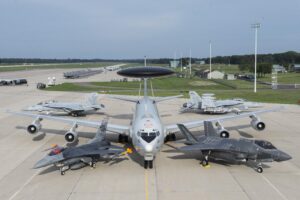
A E-3 AWACS command aircraft surrounded by (clockwise from front right) an F-35A, F-16, F-18, and EA-18G.
There is also another, subtler problem with truncating programs prematurely: sustainment. It is difficult and costly to keep a small fleet viable. Limited demand for parts means costs are never broadly amortized and vendors lack motivation to support the aircraft. This generates false perceptions that modern, advanced aircraft are inherently difficult and expensive to maintain. In fact, sustainment would be much more cost-efficient with a healthy supplier base that is motivated to innovate, committed to the product at hand, and able to amortize investment over large production runs.
Here’s an analogy: If Ford only built twenty-one F-150 pickup trucks, the same as number of B-2s built, owners would have a hard time finding spare parts and any repairs would require exquisite, bespoke solutions. It should come as little surprise that the same truth applies to combat aircraft.
Costs rise because we violate common sense production and sustainment principles, not that modern combat aircraft are uniquely hard to maintain. “Saving” money up front by limiting production, only to face exceedingly high sustainment bills on a small pool of overused aircraft that will be in the inventory for decades, is a simple matter of “penny wise, pound foolish” that will squeeze operations and maintenance accounts for years.
Invariably, small fleets of aircraft suffer a downward sustainment spiral, because uniquely advanced aircraft like the B-2 and F-22 tend to be in high demand. Their high capabilities and low numbers mean they get flown hard, taking a toll on a small number of crews and rapidly wearing out airframes. This wear and tear compounds the sustainment problem because as members of a small fleet, each plane costs more to maintain than in a properly sized force.
Out of Options?
Finally, and most importantly, an increasing number of such “high demand, low density” fleets restricts policy options available to our national leadership. To win decisively and rapidly, commanders must quickly project overwhelming force. This requires a sufficient quantity of the right tools. But the Air Force simply has too few modern bombers and fighters.
The country was willing to accept this risk in the early days after the Cold War when the world was relatively peaceful and even in post-9/11 era where non-state actors like Al Qaeda were the leading threat. However, with peer competition back on the table and existential interests at risk, the risk assessment calculus has changed. Consider the senior military commanders that were having to prepare options for North Korea a few months ago: Long range strike and air superiority were undoubtedly two crucial shortfalls. Adversaries know this, which emboldens increasingly aggressive behavior, such as China in the South China Sea or Russia in Ukraine.
The bottom line is that these problems all come down to a simple reality: lack of commitment. If the mission requirement is justifiable and enduring, the Department of Defense and Congress need to follow through with the procurement programs they have on the books. Proof regarding the wisdom of this approach lies with some of the most prolific, successful aircraft types in airpower history.
Designs like the B-52 bomber, C-130 transport, KC-135 tanker, and F-15 and F-16 fighters were produced by the hundreds and thousands. The return on investment for each one of those airplanes has extended far past what anyone could have envisioned when they first flew, with each of them still in service decades later. The buys for these aircraft were decisive in scope, so large that mission requirements were unambiguously met and older types could be prudently retired.
As a result, America was always an airpower leader because it could focus its limited resources on the future, not trying to sustain aircraft types that had become obsolete given the threats and mission demands at hand. Sustainment was never a problem because there was enough demand for market forces to keep suppliers in business. Mission demands were also balanced across a broader force, which helped retain aircrew and lengthened the life of high end planes. Most importantly, commanders had the tools required to fight and win.
While it is too late to buy more B-2s and F-22s, the Air Force still has a chance to reset its force in fashion that matches real-world demand. Looking at programs like the F-35, B-21, KC-46, T-X, and beyond, it is time for the Department of Defense and Congress to return to a concept of buying enough aircraft to meet our strategy instead of dictating strategy by arbitrary budget limits.
Senator McCain is right: This is a full-blown crisis. It is time to do the right thing: Double the buy rate on F-35A starting in 2020 and plan on a minimum of 200 B-21 bombers built in rapid fashion. That will begin to get to the Air Force that America needs to meets the challenges of the future.
By Lt Gen David Deptula, USAF (ret) and Douglas Birkey
Dave Deptula is currently Dean of the Mitchell Institute of Aerospace Studies, and Doug Birkey is the Institute’s executive director.
Subscribe to our newsletter
Promotions, new products and sales. Directly to your inbox.

